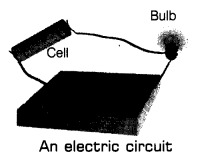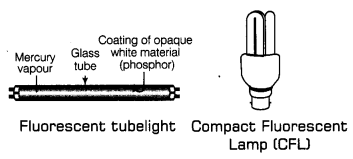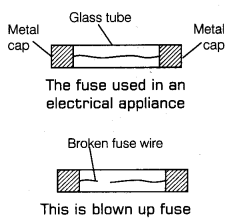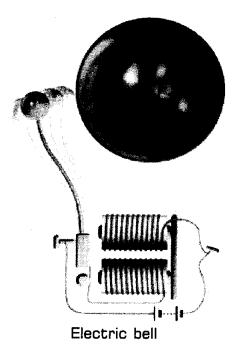CBSE Class 7 Science Notes Chapter 14 Electric Current and Its Effects
The most convenient source of energy is electricity. Electricity has a very important role because it is used to run many electrical appliances like an electric bulb, television, a stereo system, refrigerator, washing machine, computers, etc., and we cannot think our life without making use of electricity.
Electricity is produced at power stations from where it is brought to our homes through the thin wire and electric poles networks or underground cables (or wires). Here, we can define the electric current as of the flow of electricity through a conductor (wires, cables).
Actually, in everyday life, the word electricity and electric current are used in the same sense. There is another source of electricity, i.e. electric cell or battery. Now, in order to obtain electricity from a cell or battery, we have to connect it into a circuit. So, let us study about the electric circuit.
Electric Circuits
A continuous conducting path (consisting of wires, bulb, switch, etc.) between the two terminals of a cell or battery along with an electric current flows, is known as an electric circuit.
e.g. take a cell having a positive terminal (+) and a negative terminal (-). Now try to connect the positive terminal of the cell to one end of the switch with a piece of copper wire and other ends of the switch to one end of bulb holder with another piece of copper wire.
The negative terminal of the cell is connected directly to the other end of the bulb holder with a wire (as shown in the figure), so this kind of setup is known as an electric circuit.

Circuit Diagram
A circuit diagram tells us how the various components in an electric circuit have been connected by using the electrical symbols of the components.
(i) When the bulb glows In an electric circuit when the switch is closed, then the switch is said to be in the ON position. And when the switch in a circuit is open, then the switch is said to be in the OFF position. So, in an electric circuit, a bulb lights up only when the switch is in the ON position and at that time, we can say that the electric circuit is complete because the current flows throughout the circuit instantly (as shown in the figure) electric circuit
(ii) When the bulb does not glow While checking the circuit notice that sometimes the bulb does not glow even when the switch is in the ON position. This condition can occur only if the bulb gets fused, i.e. its filament breaks. It is a difficult and time-consuming job to draw the electric circuit by making the actual drawings of cell, battery, switch, bulb, etc.

So, the scientists have devised a very easy way to represent the component of an electric circuit (cell, battery, switch, bulb, etc.) with the help of symbols, which are easy to draw.
Some of the commonly used symbols for electric components are shown here:

Electric Cell and Battery
The common source of electricity to run the number of devices, e.g. torches, radio, electric clocks and watches, toys, etc., is an electric cell, but sometimes a single cell is not sufficient to run many devices as they require high voltage to run all these appliances. The cell provides much less electricity as compared to that provided by the electric supply line, e.g. in the case, a single electric cell which provides only 1.5 V of electricity, whereas electricity from the power station is supplied to our home at very high voltage of 220 V.
Combination of Electric Cells
Since the higher voltage can be obtained by combining a number of cells in series. So, when the positive terminal of one cell is joined with the negative terminal of the other cell, then the cells are said to be joined in series (as shown in figure given below). So, a battery can be defined as the group of cells joined together in the series, e.g. in a torch, the cells are placed one after the other. But in many devices, cells are not placed one after the other, e.g. in a TV remote control, the two cells are placed side by side (or parallel to each other) instead of single one. So, two or more cells connected in side by side manner are said to be joined in parallel. This combination is also known as battery.

If we combine two cells by keeping the positive terminal of one cell in contact with the positive terminal of the other cell or negative terminal of one cell in contact with the negative terminal of the other cell, then the battery obtained will not work.
The batteries which are used in cars, buses, trucks, inverters, etc., are also made of cells. There is a special feature of car battery is that its cells can be recharged. Ordinary cells, however, cannot be recharged.
Connection of Cells/Battery
‘+’ and ‘-‘ symbols are printed in the battery in order to have an exact placement of the cells in their respective battery compartment.
- The switch or key can be placed anywhere in the circuit.
- The circuit is complete and it is said to be closed only when the switch is ON.
- The circuit is incomplete and it is said to be open, only when the switch is OFF.
There is a thin wire in the bulb, called filament which glows when an electric current passes through it. So, if the bulb gets fused, then its filament gets broken.
Note: Never touch a lighted electric bulb connected to the mains as it may be very hot and can damage your hands.
Heating Effect of Electric Current
Production of heat in an electric device due to the flow of electric current is called the heating effect of electric current. We have seen an electric heater used for cooking, an electric bulb or room heater. So, when these appliances are switched ON after connecting to the electric supply, then their elements become red hot and release the heat. This happens due to the heating effect of electric current.
The degree to which a material opposes the passage of current through itself is known as its resistance. Actually, when an electric current passes through a high resistance wire, the electric energy gets converted into heat energy and this heat energy heats up the wire.
Element
All electrical heating devices consist of a coil of wire called an element. When these appliances are switched ON after connecting to the electric supply, then their elements become red hot and release the heat. There are some electric appliances such as immersion heaters, hotplates, irons, geysers, electric kettles, hair dryers, etc., which have elements inside them.
Factors on Which the Heating Effect of Current Depends
There are two factors on which the heating effect of current depends:
(i) Resistance of wire: Greater the resistance of a wire, greater will be the heat produced in it by a given
current, e.g. if we choose two wires, one of copper and other is nichrome of equal length and equal thickness and pass them the equal amount of current through them for the same duration, then we will notice that nichrome wire will become hotter in comparison to the copper wire. It is due to the reason that the resistance of nichrome wire is more than that of the copper wire.
That is why the nichrome wire is used to make heating elements of electric heating appliances such as electric room heater, electric iron, etc. The resistance of a wire depends on the material of the wire, length of wire and thickness of the wire.
(ii) Magnitude of current passed through a given wire: If the magnitude of current passed through a given wire is greater, then the heat produced in it will also be greater, e.g. if a normal amount of current flows through the copper wires of household electric wiring, then the wires do not become much hot but if a large current flows in the same wiring accidentally, then the wires become extremely hot and a fire may be started.
Applications of the Heating Effect of Current
Some of the important applications of heating effect of electric current are
- For the production of light, the heating effect of electric current is utilised in the electric bulbs.
- For the working of electrical heating appliances such as water heater, electric room heater, electric iron, etc., the heating effect of electric current is utilised.
- The heating effect of electric current is utilised in a safety device called ‘electric fuse’.

Compact Fluorescent Lamps (CFLs)
An electric bulb is basically used for producing light but it also releases the heat which is not desirable because a major part of the electricity consumed by the filament of a bulb is converted into heat and results in the wastage of electricity. So, this wastage can be decreased by using fluorescent tube light or CFLs (as shown in the figure) in place of the bulbs.
However, before purchasing bulbs, tubes orCFL’s we should look for the ISI marl? (ISI- Bureau of Indian standard). It is because the ISI mark ensures that the appliance is safe and wastage of energy is minimum.

Electric Fuse
A safety device which works on the heating effect of current and prevents electric fires or damage to electrical appliances due to excessive flow of current is known as the fuse. This safety device consists of a short length of a thin wire of tin plated copper having a low melting point and this wire has a much greater resistance than the rest of the electric wiring in the house.
So, due to this, if the current in the electric wiring suddenly increases too much, then the fuse wire gets heated, then it melts and breaks the circuit which means that the current flowing in the household circuit will stop. This prevents fire in the house and also the damage of various electrical appliances like refrigerator, fans, tube lights, TV, etc. When a fuse gets blown (breaks), a new fuse has to be fitted in its place in order to restore the electricity supply in the household circuit.

Note: We should not use a thick wire as a fuse wire because it will have low resistance and thus it will not get heated to its melting point ‘ when a large current passes through it.
Cause of Large Current Flow in Household Electric Wiring
An extremely large current can flow in the household electric wiring circuits under two circumstances overloading and short circuit. We might have read reports in the newspaper about fires caused by short circuits and overloading. Now, let’s study these two terms.
Overloading
It is a situation when too many electrical appliances are connected to a single socket, they draw an extremely large amount of current from the household circuit. The flow of large current due to overloading may heat the copper wires of household wiring to a very high temperature and fire may be started.
Short Circuit
Electric current is supplied by household through two insulated wires which run together and reach each and every electrical appliances. One insulated wire is called live wire and the other insulated wire is called neutral wire and both these wires are necessary for the working of an electrical appliance (say an electric iron).
So, if in case the plastic insulation of the live wire and the neutral wire gets worn due to wear and tear, then the two naked wires touch each other. So, this touching of live wire and neutral wire directly is known as a short circuit. Due to which a large current flows through the household wiring and this large’ current may heat the wires to a dangerously high temperature and a fire may be started.
Note: Always use proper fuses which have been specified for particular applications carrying ISI mark Never use just any wire or strip of metal in place of a fuse.
Miniature Circuit Breakers (MCBs)
This ore increasingly being used these days in place of fuses. MCB does not work on the heating effect of current as it works on the magnetic effect of current. These switches outomaticoUy turn OFF when the current in a circuit exceeds the safe limit. We turn them ON and the circuit ¡s once again completed.

Magnetic Effect of Electric Current
If the electric current passes through a wire, then the current carrying wire behaves like a magnet. This phenomenon is known as the magnetic effect of current. It was discovered by a scientist Hans Christian Oersted who found that when an electric current is passed in a wire, then the compass needle placed near it got deflected from its usual North-South position.
A straight wire carrying an electric current produces a magnetic effect. The magnetic effect is increased only if we use a long coil of wire instead of a straight wire. Even further the magnetic effect is increased if the coil of wire is wound around an iron rod and then current is passed through it.
Electromagnets
It is a magnet made by using electric current. An electromagnet works on the magnetic effect of current. An electromagnet consists of a coil of insulated wire wrapped around a piece of iron which is magnetised only when an electric current is passed through the coil.

This magnet consists of a long coil of insulated copper wire wound around an iron rod and when the two ends of the coil get connected to a cell, then a current passes through the coil and produces a magnetic effect. The magnetic effect magnetises the iron rod. In this way, the iron rod becomes an electromagnet. The magnetism of an electromagnet remains as long as the current is flowing in its coil. So, if we switch OFF the current in the coil, then all the magnetism of the iron rod disappear and it will no longer behave like a magnet.
There are two factors through which an electromagnet can be made stronger, i.e.
- By increasing the amount of current used in the coil.
- By increasing the number of turns forming the coil.
Uses of Electromagnets
- These magnets are used in electrical appliances such as an electric bell, electric fan, electric motor.
- These magnets have their utilisation in electric generators where the very strong magnetic field is required.
- For deflecting electron beam of the picture tube of TV electromagnets are used.
- For the magnetic separation of iron ores from the earthly substances, electromagnets are used.
- For preparing strong permanent magnets, electromagnets are used.
Advantages of Electromagnets over Permanent Magnets
An electromagnet is a temporary form of the magnet because its magnetism is only for the duration of current flowing in its coil. Actually, an electromagnet is better than a permanent magnet in many respects. There are some of the advantages of the electromagnets over the permanent magnets which are stated as follows:
- The magnetism of an electromagnet can be switched ON or switched OFF as desired. While it is not possible with a permanent magnet.
- By increasing the number of turns in the coil and by increasing the current passing through the coil an electromagnet can be made very strong. On the other hand, a permanent magnet cannot be made so strong.
Electric Bell
An electric bell works on the magnetic effect of current. It has an electromagnet in it. Let us study its construction and working as well.
Construction of Electric Bell
The electric bell has a U-shaped electromagnet. There is a small iron bar called armature which is h^d in front of the poles of the electromagnet. The lower end of the iron bar is attached to a flat spring and the flat spring is itself fixed to a metal bracket. The upper end of the iron bar has a clapper attach to it. A metal gong is fixed near the clapper.
Working of Electric Bell
In order to ring the bell, first of all, we press the push button switch in order to ring the bell. So, when we press the switch, then the electric circuit of the bell is completed and a current passes through the coil of the electromagnet and it gets magnetised. The electromagnet attracts the iron armature towards itself.
So, as the armature moves towards the poles of the electromagnet, the clapper attached to it strikes the gong and produces a ringing sound. It implies that the bell rings.

When the armature moves towards the magnet, its contact with the contact screw is broken. Due to this, the electric circuit breaks and no current flows in the electromagnet coil. The electromagnet loses its magnetism for a moment and the armature is no longer attracted by it. The flat spring brings back the iron armature to its original position and the clapper also moves away from the gong.
As soon as the armature comes back and touches the contact screw the circuit is completed and current starts flowing in the electromagnet coil again. The electromagnet attracts the iron armature once again and the clapper strikes the gong again producing a ringing sound.
So, this process of ‘make and break’ of the electric circuit continues as long as we are pressing the switch. Due to this, the armature vibrates forwards and backwards rapidly each time making the clapper strike the gong. Thus, the clapper strikes the gong rapidly producing an almost continuous sound.